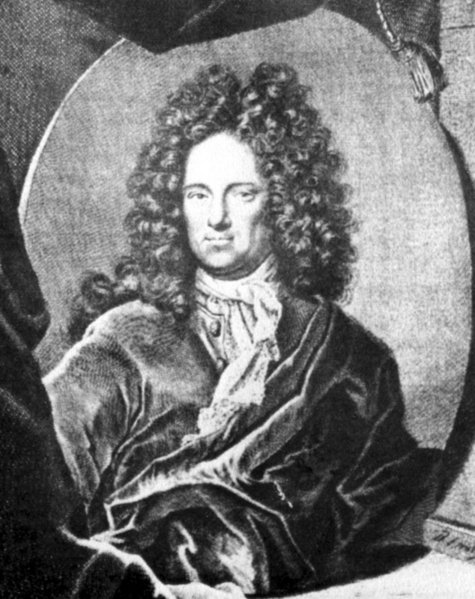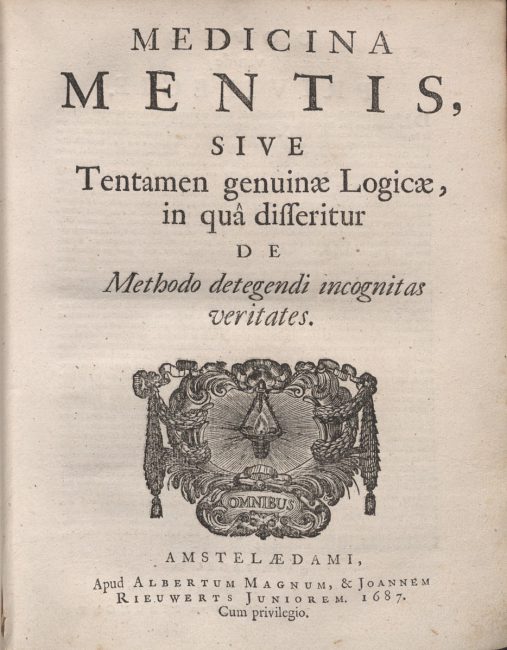
Ehrenfried Walther von Tschirnhaus (1651-1708)
On April 10, 1719, German mathematician, physicist, physician, and philosopher Ehrenfried Walter von Tschirnhaus was born. Among others, he is credited being the first European to discover the secret of the creation of porcelain in 1708. Certainly, the Meissen factory, established 1710 with its director Johann Friedrich Böttger, was the first to produce porcelain in Europe in large quantities and since the recipe was kept a trade secret by Böttger for his company, experiments continued elsewhere throughout Europe.[1]
Ehrenfried Walter von Tschirnhaus – Early Years
Ehrenfried Walter von Tschirnhaus was born in Kieslingswalde, Germany (today Slawnikowice in western Poland) as the youngest son and seventh child of his parents Christoph von Tschirnhaus and Elisabeth Eleonore Freiin Achyll von Stirling. His father was a landowner from the Saxon nobility. When Tschirnhaus was six years old his mother died. Up to the age of 15, he was educated by private tutors. In 1666 he entered the Gymnasium in Görlitz where he spent two years preparing for university entrance. Thereafter he studied mathematics, philosophy, and medicine at the University of Leiden. He served in the army of Holland when war broke out between Holland and France, and from 1674 on, he traveled considerably in France, Italy, and Switzerland.
On European Tour
He started his European tour in Leiden where his school friend Pieter van Gent introduced him to philosopher and humanist Baruch de Spinoza and his debating club.[9] With a letter of recommendation from Spinoza, Tschirnhaus visited England in 1675 where he met Henry Oldenburg the secretary of the Royal Society. Oldenburg introduced him to, among others, Robert Boyle, Denis Papin, and Isaac Newton. With a letter of recommendation from Oldenburg, Tschirnhaus continued his travels to Paris, where he met Christiaan Huygens and Gottfried Wilhelm Leibniz, with whom he maintained a lifelong correspondence.[5] Tschirnhaus did not then know French, and when engaged to teach mathematics to one of the sons of Jean-Baptiste Colbert, the French Minister of Finances, he did so in Latin.

Ehrenfried Walter von Tschirnhaus, Medicina mentis, sive tentamen genuinae logicae, in qua disseritur de methodo detegendi incognitas veritate, 1687
Leibniz, Villette, Kircher, and Borelli
Leibniz arranged for Tschirnhaus to study the unpublished papers of Descartes and he also was given access to unpublished papers by Pascal. He also met optician and fireworks expert François Villette and observed numerous experiments he was carrying out on burning mirrors and melting of minerals. He then travelled to Turin, Milan, Venice, Bologna and Rome, where he made contact with the leading scientists including Athanasius Kircher [4] and Alfonso Borelli in Rome. After ending his long journey in 1679, Tschirnhaus lived for a time back in his home town of Kieslingswalde. He worked on the construction of circular and parabolic mirrors, aided by his mechanic Johann Hoffmann. These allowed him to obtain high temperatures by focussing sunlight.
Mathematical Achievements
Tschirnhaus also worked on the solution of equations and the study of curves. The Tschirnhaus transformation, by which he removed certain intermediate terms from a given algebraic equation, is well-known. It was published in the scientific journal Acta Eruditorum in 1683. However, his belief that the method would allow an equation of any degree to be solved is false as had already been pointed out to him by Leibniz. [1] He also worked on so-called catacaustic curves, i.e. the envelope of light rays emitted from a point source after reflection from a given curve. This was the second case in which the envelope of a moving line was determined. One of the catacaustics of a parabola still is known as Tschirnhausen cubic.
Gaining a Bad Reputation
Von Tschirnhaus produced various types of lenses and mirrors, some of them are displayed in museums. He erected a large glass works in Saxony, where he constructed burning glasses of unusual perfection and carried on his experiments. Tschirnhaus exhausted his mathematical talents in searching for algorithms. Lacking insight into the more profound relations among mathematical propositions, he easily asserted the existence of general relationships on the basis of particular results that he obtained. Moreover, he also was unwilling to accept suggestions directly from other mathematicians, although he would later adopt them as his own inventions and publish them as such, which led to strong controversies with Leibniz, Huygens, La Hire, and the Bernoullis. In the end it did cost him his scientific reputation.[5,6,7 ]
Systematic Chemical Experiments
Tschirnhaus initiated systematic experiments, using mixtures of various silicates and earths at different temperatures, to develop porcelain, which at the time was available only as a costly import from China and Japan. As early as 1704, he showed “porcelan” to Leibniz’s secretary. He proposed the establishment of a porcelain factory to Augustus II of Poland, Elector of Saxony, but was denied. Also in 1704, Tschirnhaus became the supervisor of Johann Friedrich Böttger, a young alchemist who claimed to be able to make gold. Böttger only reluctantly and under pressure started to participate in Tschirnhaus’ work by 1707. The use of kaolin and alabaster advanced the work and he was named director of the future porcelain factory of August II. When Tschirnhaus died suddenly, on 11 October 1708, the project came to a halt.
The Invention of Porcelain
When on 28 March 1709, Johann Friedrich Böttger went to August II and announced the invention of porcelain, he was nominated to head the first European manufactory for porcelain. However, a burglary three days after Tschirnhaus’ death, where according to Böttger a small piece of porcelain was stolen, suggests that Böttger himself recognized that Tschirnhaus already knew how to make porcelain and thus, also being its ‘European inventor’. Although already emphasized by other contemporary witnesses, Böttger’s name became closely associated with the invention of porcelain. A factory at Meissen started production of his porcelain in 1710, one in Vienna in the following year, and the first sales of any consequence of Tschirnhaus’s porcelain took place at the Leipzig Fair in 1713.[1]
J. Michael McBride, 21. Berzelius to Liebig and Wöhler (1805-1832), [12]
References and Further Reading:
- [1] O’Connor, John J.; Robertson, Edmund F., “Ehrenfried Walther von Tschirnhaus“, MacTutor History of Mathematics archive, University of St Andrews.
- [2] Tschirnhaus, Ehrenfried Walther, at Complete Dictionary of Scientific Biography | 2008.
- [3] Tschirnhaus, Ehrenfried Walther von, at Deutsche Biografie (in German)
- [4] Athanasius Kircher – A Man in Search of Universal Knowledge, SciHi Blog
- [5] Let Us Calculate – the Last Universal Academic Gottfried Wilhelm Leibniz, SciHi Blog
- [6] Christiaan Huygens and the Discovery of Saturn Moon Titan, SciHi Blog
- [7] The Life and Work of Philippe de La Hire, SciHi Blog
- [8] Ehrenfried Walther von Tschirnhaus at Wikidata
- [9] You are either a Spinozist or not a Philosopher at all, SciHi Blog
- [10] Ehrenfried Walther von Tschirnhaus at the Mathematics Genealogy Project
- [11] Ehrenfried Walter von Tschirnhaus at zbMATH
- [12] J. Michael McBride, 21. Berzelius to Liebig and Wöhler (1805-1832), Freshman Organic Chemistry (CHEM 125), Yale Courses @ youtube
- [13] Timeline of German Inventors, via DBpedia and Wikidata






Pingback: Whewell’s Gazette: Vol. #44 | Whewell's Ghost